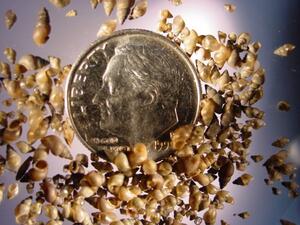New Zealand mudsnail (Potamopyrgus antipodarum)
Where did the New Zealand mudsnail come from?
- Native to New Zealand, this species was first discovered in the Snake River in Idaho and the Madison River in Montana in 1987 and has rapidly spread throughout the western United States. In 2006, the New Zealand mudsnail spread to waters in Oregon, California, Minnesota, and Wisconsin.
- The New Zealand mudsnail has not been reported in Kansas, but is considered a priority species because of its rapid spread and the late 2004 introduction into Colorado.
What do New Zealand mudsnails look like?
- Mature New Zealand mudsnails average 5mm in length and have brown or black cone-shaped shells with five whorls.
Why are New Zealand mudsnails a problem?
- IT ONLY TAKES ONE!--The New Zealand mudsnail has the ability to reproduce quickly and mass in high densities. The highest recorded densities reported are 800,000/m2 in Lake Zurich, Switzerland, where this species colonized the entire lake in less than seven years.
- NZMS disrupt the food chain by consuming algae in the stream and competing with native bottom-dwelling invertebrates. A population crash of invertebrates can follow the introduction of NZMS, which reduces fish forage. With a decrease in food availability, fish populations may decline as well.
How are New Zealand mudsnails spread?
- Unintentional transport by people is probably the primary vector for the spread of New Zealand mudsnails.
- Mudsnails are able to withstand desiccation, a variety of temperatures, and are small enough that many types of water users (anglers, swimmers, pets) could inadvertently transfer this nuisance species. Remember it only takes one to start an infestation.
What can we do to control the spread of New Zealand mudsnails?
The following procedures for cleaning NZMS infested wading gear can be followed upon exiting NZMS infested waters. Wading gear should be cleaned prior to leaving the site. If this is not possible then wading gear should be completely sealed inside of a large plastic bag and cleaned before it is used in any other waters. Two different cleaning procedures are recommended using Formula 409® Disinfectant: Dilute the commercially available solution 1:1 with clean water to achieve the needed concentration for the cleaning solution (i.e. 1 gallon of Formula 409® Disinfectant to 1 gallon of water).
1) Immersion Procedure
a. Remove wading gear upon exiting NZMS infested waters. Avoid allowing infested wading gear to come in contact with interior surfaces of vehicles or camping gear such as tents or trailers. NZMS can be transferred to any surface they come in contact with and they could later be transferred back to cleaned wading gear. Turn waders right side out and remove insoles from wading boots.
b. Place waders, wading boots, boot insoles and the streambed contact end of a wading stick, if used, in a container of sufficient size to allow the gear to be completely covered by a cleaning solution.
c. Pour sufficient Formula 409® Disinfectant cleaning solution into the container with the infested wading gear to completely cover the gear. It may be necessary to weight down the gear to ensure that it remains immersed in the cleaning solution.
d. Allow the wading gear to remain in the cleaning solution for at least 5 minutes.
e. Remove the wading gear from the cleaning solution one piece at a time and inspect it to make sure that all debris that could harbor NZMS has been removed from the gear as well as any NZMS that could be lodged in cracks or crevices. If necessary, use a stiff plastic bristled brush such as a kitchen brush to remove any remaining debris and mud.
f. Rinse wading gear in clean water. DO NOT USE WATER FROM THE NZMS INFESTED SOURCE. This may reintroduce NZMS to the wading gear.
g. Return cleaned wading gear to it appropriate storage container.
2) Dry Sack Procedure
a. Remove wading gear upon exiting NZMS infested waters. Avoid allowing infested wading gear to come in contact with interior surfaces of vehicles or camping gear such as tents or trailers. NZMS can be transferred to any surface they come in contact with and they could later be transferred back to cleaned wading gear. Turn waders right side out and remove insoles from wading boots.
b. Place waders, wading boots, and boot insoles into a dry sack (recommended size: 65 liter). Walking sticks will need to be cleaned separately outside of the dry sack to avoid rupturing the sack.
c. Add 8 to 10 liters of Formula 409® Disinfectant cleaning solution to dry sack and the seal dry sack.
d. Pick up the dry sack and shake it back and forth using a rolling motion to ensure that the contents are thoroughly coated with the cleaning solution. Continue shaking for approximately 30 seconds.
e. Let dry sack sit undisturbed for at least 5 minutes. Then repeat the shaking and mixing for another 30 seconds.
f. Open the dry sack and remove the contents one piece at a time and inspect it to make sure that all debris that could harbor NZMS has been removed from the gear as well as any NZMS that could be lodged in cracks or crevices. If necessary, use a stiff plastic bristled brush such as a kitchen brush to remove any remaining debris and mud.
g. Rinse wading gear in clean water. DO NOT USE WATER FROM THE NZMS INFESTED SOURCE. This may reintroduce NZMS to the wading gear.
h. Return cleaned wading gear to it appropriate storage container.
What do I do if I find New Zealand mudsnails?
If you find a New Zealand mudsnail, do not release it back into the water, note the date and location, and call the Emporia Research Office at (620) 342-0658 or email the Aquatic Nuisance Species Coordinator.
Images and Recent news
New Zealand mudsnail links:
Fishing Equipment Cleaning Recommendation
New Zealand Mudsnail Fact Sheet
https://cpw.state.co.us/aboutus/Pages/ISP-NZ-Mudsnail.aspx
http://fieldguide.mt.gov/speciesDetail.aspx?elcode=IMGASY1010










